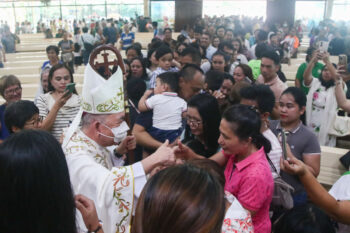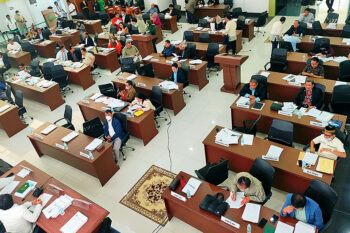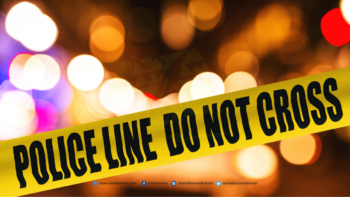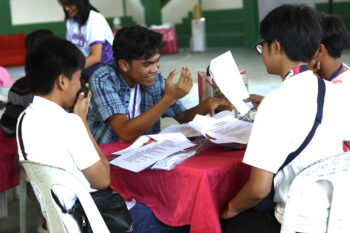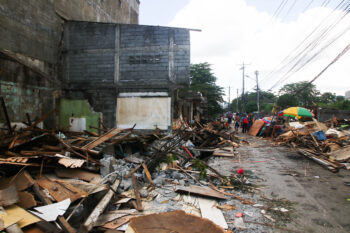
(Author’s Note: The year 2023 marks a century since the bloody Colorum Uprising exploded on December 27, 1923 in Socorro, Bucas Grande Island, Surigao del Norte province. Nowadays, the same town is grappling with a serious problem of religious fanaticism and violence. The specific instances are radically different though: sex abuse and rape, forced child marriages, financial extortion, etc. The personification of evil? In 2023, it is Señor Aguila; in 1923 it was Lantayug. But we are hopeful that our senators and the local government of Surigao del Norte have provided a wise and timely approach to solving the problem faced by the people of Socorro. And the greatest hope is that bloody violence could be averted)
In 1923, a millenarian group of fanatical believers based in Socorro on Bucas Grande Island of Surigao province got into a bloody encounter with the Philippine Constabulary, a paramilitary police force, that eventually cost numerous lives on both sides.
The Colorum, as they were called, settled in Socorro and called it the New Jerusalem. This is a recurring event in Philippine history where a religious cult expressed the profound grievances of an oppressed people and developed an isolated community that aspire to achieve a utopian vision. Eventually they would encounter the authority of the State that felt threatened by their autarky and suppressed them. Bloody events would follow, and in the case of the Colorum, they would culminate in bloody encounters in the island of Bucas Grande, at the Surigao mainland and extending towards Agusan along the Lake Mainit area.
The term “colorum” that has come to designate a number of fanatical groups in Luzon and the Visayas is derived from the Latin expression of a Catholic prayer, per omnia saecula saecolorum, or forever and ever, thus a world without end. In a historical essay by Milagros C. Guerrero in the Asian Studies Journal, she noted that the Colorum movements that thrived in Nueva Ecija, Rizal, Tarlac, La Union and Batangas eventually found their way in Surigao. Its provenance dated much earlier in 1843 during the Spanish colonial era when Apolinario de la Cruz founded the Cofradia de San Jose in Tayabas (present-day Quezon province).
Guerrero noted that “the same fanatic fervor dominated the Colorums of Surigao who organized themselves as devotees of the Sacred Heart of Jesus and Immaculate Heart of Mary. Jose Rizal, who was believed to have been resurrected, was venerated as a god who would later on rule the Philippines. Under his rule, the property of those who refused to join the society would be confiscated and distributed among the Colorums. The members were assured that in case of an uprising, the guns of their enemy would not fire towards them, or in case the guns would fire, the Colorums would not be wounded. If, by accident, any of them were hit, or died, he would revive or resurrect within five days. Assured thus, the Colorums increased in numbers and spread to Agusan, Cotabato, Samar and Leyte.”
On August 16, 1977, an account of the tragic uprising was written by Zosimo P. Mahomoc, son of one the few surviving leaders of the Colorum, Candido Mahomoc. Candido was among the leaders who drew long sentences of twenty to forty years, but was granted clemency for good behavior and was released after a few years. Many of the 45 inmates, including their divine intermediary Lantayug, died of heart attack and tuberculosis while in prison.
How It Started
In the quiet and isolated town of Socorro (its original barrio was called Pamosaingan), the ordinary farming and fishing folk were deeply religious, with most of them members of the Catholic Apostleship of Prayer, and they were led by Gerardo ‘Andoy’ Lasala. In 1922, a certain Juan ‘Bajao’ Cañete came, bearing the teaching of Gregorio Aglipay of the Iglesia Filipina Independiente sect. In retrospect, there was suspicion that Cañete was actually an advance party for Felix Bernales, alias Lantayug. The latter was responsible for introducing some fanatical beliefs. In 1923, Bernales left the island, but made an allegorical statement that he would send a letter “when their redemption is at hand.”
The leadership of the Colorum was mostly exercised by Visayan migrants from Cebu, Bohol and Leyte, like Felix Bernales who sported the name Lantayug. A vein that runs through Philippine colonial history, ordinary folks who felt a deep grievance against persons in authority sought another approach to restitution by joining outwardly religious fraternities. It would soon become a volatile mix of religiosity, communalism and belief in magical invincibility.
There were suspicions about the strange goings-on in the island, but the soldiers and policemen from Dapa and Numancia (Siargao island) who first went there were assured that the local folk were just pious believers. Later, Pablo Lagapa, Martin Telin and Diego Juanite were maltreated severely by another group of policemen.
Under the leadership of Gorgonio Timcang, a revenge was hatched against the police. Jose, the brother of Diego Juanite, and Albino, the son of Pablo Lagapa, came home from their high school studies in Cebu and Bohol, respectively, when notified about the maltreatment of their kin. By coincidence, a letter from Lantayug came, further roiling their emotions.
As recounted by Candido Mahomoc through his son, the Colorum uprising had begun.
During the Christmas season in 1923, Jose Juanite and Martin Telin killed three informers and one policeman in Pamosaingan, while Albino Lagapa and his group killed two policemen and one prisoner in Socorro. Later, Albino killed the police chief and a policeman.
By January 8, 1924, some 20 PC (Philippine Constabulary) soldiers came to Pamosaingan. Led by Capt. Valentin Juan, provincial commander of Surigao, and Lt. Juan Guillermo, they came upon a group of men gathered in a house. Sensing that they were Colorum members, the troop opened fire, killing eight.
Jose Juanite led the counter-attack with their bolos and a bloody battle ensued. Overwhelmed by the more numerous Colorum, the soldiers retreated to their boat, leaving 16 dead, including the two officers. Some 40 Colorum rebels died in the encounter, including Jose Juanite.
The Punitive Expedition
The heavy casualties provoked a punitive reaction from the government, and the patrol ship (PG-19) Sacramento shelled Socorro. An expeditionary force commanded by Lt. Col. Clarence Bowers had 100 riflemen and an attached unit of Marines who handled the machine guns. A veteran of battles in Cuba, Sulu, and Samar, Bowers later claimed the efficacy of his armaments “due to the terror inspired in the Colorums by the machine guns.” He proceeded to burn Socorro town.
Guerrero would write that “the Constabulary allowed the corpses to rot on the spot where they fell, the better to prove to all and sundry that the Colorums do not have supernatural powers to resurrect themselves. The purpose of the Constabulary was now clear: to avenge themselves in a relentless campaign against the rebels.”
Most of the fighting, however, occurred in mainland Surigao. The Colorum groups were spread in Placer and in nearby towns up to the borders with Agusan. Given the overwhelming force of the well-armed and disciplined American army, the unlettered fanatics lost all armed engagements.
The relentless pursuit of the reinforced American expeditionary forces from other provinces and a compliant local government proved too much for the Colorums. By October 1924, the ragtag forces of the Colorum that has been dismissed by the government as “a mere fanatical movement of a religious nature” proved no match to the American firepower and had been effectively quelled. The surviving leaders of the uprising drew long prison terms, over 100 followers were slain, some 500 surrendered, and an untold number with lesser involvement were pardoned and joined mainstream society.
The Lessons of History
There were attempts by Filipino officials to examine more deeply the events and their underlying causes, but to no avail. Senator Jose Clarin’s attempt to investigate the event was quickly shot down by Col. Bowers who claimed that the burning of Socorro was necessary for the safety of his men.
Exactly a century after the bloody Colorum Uprising, there is so much to learn from it. We cannot anymore, and should not, close our eyes to existing instances of social injustices that breed deep grievances among our people. Nor should we allow ignorance to fester among the downtrodden because they will resort to the bloodiest means to resolve the ills of society. And finally, the uprising was a message to our politicians to cleanse the cesspools of corruption and to provide a justifiable hope for our people that they can overcome their current problems.
( MindaViews is the opinion section of MindaNews. Greg Hontiveros of Butuan City is an independent researcher on historical studies. Hontiveros has two published books and a dozen papers published in the Journal of History and some university journals. His focus is on aspects of Mindanao history and culture. This piece was first posted on his FB page. MindaNews was granted permission to re-publish this).


